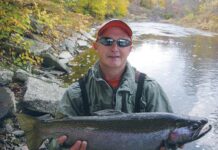Many producers are looking for ways to improve their pasture yields. The good news is that there are several things that can be done.
You can improve pasture fertility. You could plant improved forage varieties. You can manage the grazing of a pasture by removing the livestock before the grazed plants regrow.
When you remove the livestock, you make sure half of the leaf area is left. You can manage to give the plants plenty of time to recover before grazing again.
Biggest task
You can also work to keep the plants vegetative. The biggest task for the month of May is keeping the plants vegetative. In fact, most experienced graziers I know get pretty fanatical about keeping their pastures vegetative.
This task is simple. To keep the plants vegetative, you have to remove the reproductive tillers before they produce seed. In other words, do not let your pasture plants have sex. You do not want to see reproductive tillers because letting the grass plants produce seed will decrease yield.
Reproductive tillers reduce yields in two ways.
First, reproductive tillers elongate above the other tillers on the plant and shade out the vegetative tillers. Competition for sunlight means the other vegetative tillers are growing less. Less sunlight reaching the crowns of the grass plants also means that fewer vegetative buds on the crown will develop into tillers.
Hormones
The second way reproductive tillers reduce yield is by producing hormones as the seeds mature that retard or inhibit the development of other vegetative tillers. The grass plant will not produce more vegetative growth until the seeds completely mature or the reproductive tiller is removed.
Remember, the plant’s priority is to put its resources into the development of a mature seed, not to grow high-quality vegetative material.
Yield in pastures is heavily influenced by the density of the pasture. In pastures, a greater number of tillers contribute more to yield than taller plants.
When should you remove the reproductive tillers? To keep our pastures vegetative, reproductive tillers should be removed between boot and flowering. Each grass plant has multiple tillers. Initially, in the spring, all the tillers produce vegetative growth.
Range of time
For each grass, there is a range of light to dark time where those tillers induced to flowering when they were developed last fall switch from vegetative growth to reproductive growth. The reproductive tiller elongates and stem formation begins. The seed head develops and is pushed up and out of the tiller.
Boot stage is when the seed head is just about ready to emerge from the last elongated node area and is still wrapped in a leaf sheath. After the seed head emerges from the leaf sheath, the reproduction continues with flowering, seed development, seed growth and seed maturation.
Unlike vegetative tillers that have the growing point near the soil surface, the growing point in a reproductive tiller is generally found just below the last completed node. This growing point is vulnerable to grazing or clipping.
If the growing point is removed, then regrowth will come from the development of new tillers. One caution — there can be more than one reproductive tiller on a plant. Even though our cool-season grasses produce seed heads in the spring, those tillers were actually developed during the preceding fall.
Dominate
Once reproductive growth is initiated in the spring, one reproductive tiller will dominate. If reproductive tillers are removed and light conditions are still right to initiate reproductive growth, another tiller initiated last fall will start reproductive growth.
I have seen orchardgrass 3 inches tall with a flowering seed head. Because of this, some producers may want to wait until most of the reproductive tillers have developed seed heads before clipping later in the grazing season. You could wait, but you will lose yield.
Two of my colleagues have said that clipping after flowering is either cosmetic or for revenge, not to stimulate vegetative growth. Every tiller on a grass plant is not a reproductive tiller.
Fall tillers
Only those tillers induced the preceding fall have the capacity to produce a stem and seed head; the new tillers developed in the early spring will not produce a seed head.
Eventually, the light conditions will change, no longer initiating reproductive growth and all the growth for the rest of the year will be vegetative. Removing reproductive tillers can be accomplished with grazing livestock or mowing. Livestock can best do this with high stocking densities and moving livestock quickly from one paddock to the next.
The goal is to use the livestock to just graze the top couple of inches of the grass. To effectively do this, a heavy stocking density and small paddock size is needed.
If the grass is not grazed uniformly enough to avoid seed head formation, then some mechanical clipping will be needed.












